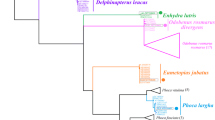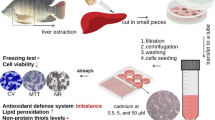Abstract
The differential cytotoxic effects of cadmium on fish and mammalian epithelial cells in established and primary culture were assessed by looking at the reduction of the colony-forming ability and reduction in the extent of growth. The influence of medium composition on the toxicity of cadmium was also studied using serum-free and serum-containing media. The experiments using immortalized cell lines showed that mammalian cells were more sensitive than fish cells to cadmium. Both cell types were grown at the same serum concentration. However, using the normal primary system, human epithelial tissue explants showed less sensitivity to cadmium than did similar cultures from rainbow trout. It is likely that cellular mechanisms of cadmium resistance in the different cell types are responsible for these effects. As expected, cadmium proved to be more toxic when tested in serum-free medium. With fish skin primary cultures, reduction of cell numbers was observed at concentrations as low as 5 μmol/L in serum-free medium compared to 100 μmol/L in serum-containing medium. This was found to be due to the reduction in the activity of free cadmium ions, caused by the presence of serum in the medium. It is concluded that serum-free formulations are probably preferable when testing pollutants in vitro. The results highlight the importance of establishing species-specific pollution tests and standardizing variables.
In summary, the results show species and culture media differences in cadmium toxicity and suggest that caution is required when extrapolating results for pollutant effects from one in vitro system to another.
Similar content being viewed by others
Abbreviations
- CE:
-
colony-forming efficiency
- EPC:
-
epithelioma papulosum cyprini
- KGM:
-
Clonetics Keratinocyte Growth Medium
References
Abbracchio MP, Evans RM, Heck JD, Cantoni O, Costa M. The regulation of ionic nickel uptake and cytotoxicity by specific amino acids and serum components. Biol Trace Elements Res. 1982;4:289–301.
Alabaster JS, Lloyd R. Cadmium. In: Alabaster JS, Lloyd R, eds. Water quality criteria for freshwater fish. 2d ed. Sevenoaks: Butterworths; Cambridge: Cambridge University Press; 1984:121–9.
Babich H, Borenfreund E. Cytotoxicity and genotoxicity assays with cultured fish cells: a review. Toxicol In Vitro. 1991:5(1):91–100.
Bakka A, Rusgatad HE. Uptake and egress of cadmium in cultures of cadmium resistant and corresponding ‘wild type’ cells. Acta Pharmacol Toxicol. 1981;48:81–6.
Beatti JH, Pascoe D. A cadmium binding protein in rainbow trout. Toxicol Lett 4. 1979;241–6.
Bols NC, Boliska SA, Dixon DG, Hodson PV, Kaiser KLE. The use of fish cell cultures as an indication of contaminant toxicity to fish. Aquatic Toxicol. 1985;6:147–55.
Bonham K, Zafarullah M, Gedamu L. The rainbow trout metallothoineins: molecular cloning and characterization of two distinct cDNA sequences. DNA. 1987;6:519–28.
Borenfreund E, Puerner JA. Cytotoxicity of metals, metal-metal and metal chelator combinations assayed in vitro. Toxicology. 1986;39:121–4.
Bowser DH, Frenkel K, Zelikoff JT. Effects of in vitro nickel exposure on the macrophage-mediated immune functions of rainbow trout (Oncorhynchus mykiss). Bull Environ Contam Toxicol. 1994;52:367–73.
Bylander JE, Li Shu-li, Sens MA, Hazen-Martin D, Re GG, Sens DA. Induction of metallothionein mRNA and protein following exposure of cultured human proximal tubule cells to cadmium. Toxicology Lett. 1994;71: 111–22.
Carballo M, Torroba M, Muñoz MJ, Sanchez C, Tarazona JV, Domínguez. Effect of copper and cyanide on some immunological parameters and stress in rainbow trout (Oncorhynchus mykiss). Fish Shellfish Immunol. 1992; 2:121–9.
Castaño A, Vega M, Tarazona JV. Acute toxicity of selected metals and phenols on RTG-2 and CHSE fish cell lines. Bull Environ Contam Toxicol. 1995;55(2):222–9.
Cleland GB, Sonstegard A. Natural killer cell activity in rainbow trout (Salmo gairdneri): effect of dietary exposure to aroclor 1254 and/or mirex. Can J Fisheries Aquatic Sci. 1987;44:636–8.
Cohen JJ. Methodological issues in behavioural immunology. Immunol Today. 1987;8(2):33–4.
Cossarini-Dunier M. Effects of pesticides atrazine and lindane and of manganese ions on cellular immunity of carp. Cyprinus carpio. J Fish Biol. 1987;31(Suppl.A):67–73.
Doyle A, Griffiths JB, Newell DG. Basic techniques for primary cell cultures and establishment of continuous cultures. In vitro tissue culture — a strategy. In: Doyle A, Griffiths JB, Newell DG, eds. Cell and tissue culture: Laboratory procedures. Porton Down: Wiley; 1993; Chap 3, Part 01.
Enger MD, Ferzoco LT, Tobey RA, Hildebrand CE. Cadmium resistance correlated with cadmium uptake and thionein binding in CHO cell variants Cdr 20F4 and Cdr 30F9. J Toxicol Environ Health. 1981;7:675–90.
Failla ML, Cousins RJ, Mascenik MJ. Cadmium accumulation and metabolism by rat liver parenchymal cells in primary monolayer culture. Biochim Biophys Acta. 1979;583:63.
Fijan N, Sulimanovic D, Bearzotti M et al. Some properties of the epithelioma papulosum cyprini (EPCMC) cell line from carp Cyprinus carpio. Ann Vir (Inst Pasteur). 1983;134E:207–20.
Freshney RI. Cloning and selection of specific cell types. In: Freshney RI, ed. Cell culture of animal cells. A manual of basic technique. 3d ed. New York: Alan R. Liss; 1994; Chap 11:137.
Goering PL, Klassen CD. Tolerance to cadmium-induced toxicity depends on presynthesized metallothionein in liver. J Toxicol Environ Health. 1984;14:803–12.
Hildebrand CE, Tobey RA, Campbell EW, Enger MD. Cadmium resistant variant of the chinese hamster (CHO) cell with increased metallothionein induction capacity. Exp Cell Res. 1979;124:237–46.
Hsie A, Schanley RL, Tan EL et al. The toxicity of sixteen metallic compounds in Chinese hamster ovary cells: a comparison with mice and Drosophila. In: Goldberg AM, eds. Alternative methods in toxicology. Acute toxicity testing: alternative approaches. Liebert: New York. 1984;2:115–25.
Iger Y, Lock RA, Van der Meij JC, Wendelaar Bonga SE. Effects of water borne cadmium on the skin of the common carp (Cyprinus carpio). Arch Environ Contam Toxicol USA. 1994;26(3):342–50.
Ikeda M, Watanabe T, Kasahara M, Nakasuka H. Nutrient intake of women in rural and urban areas in Japan. Asia Pacific J Publ Health. 1988;2:28–32.
IPCMES, International programme on chemical safety. Environmental health criteria 134. Cadmium. Geneva: WHO; 1992a.
IPCMES, International programme on chemical safety. Environmental health criteria 135. Cadmium environmental aspects. Geneva: WHO; 1992.
IRPTC. IRPTC legal file 1986, Geneve, International Register of Potentially Toxic Chemicals, United Nations Environmental Programme. 1987; vol.1.
Kagi JHR, Valle BL. Metallothionein: a cadmium- and zinc-containing protein from equine renal cortex. II. Physicolchemical properties. J Biol Chem. 1961;236:2435–42.
Kaji T, Mishima A, Yamamoto C, Sakamoto M, Koizumi F. Effect of cadmium on the monolayer maintenance of vascular endothelial cells in culture. Toxicology. 1992;71:267–76.
Klung S. Beitrag zum transport mechanismus der Cadmiumaufnahme in CHO-Zellen [Doctoral thesis]. University of Heidelberg; 1988.
Kocan RM, Landolt ML, Sabo KM. In vitro toxicity of eight mutagens/carcinogens for three fish cell lines. Bull Environ Contam Toxicol. 1979;23:269–74.
Langdon JS. Environment and management factors in diseases of fish. In: Fish diseases. Proceedings 106: Proceedings of a conference, University of Sidney, 1988:329–53.
Levi PE. Toxicity of chemicals. In: Hodgson E, eds. A textbook of modern toxicology. New York: Elsevier Science; 1977:175.
Margoshes M, Valle BL. A cadmium protein from equine kidney cortex. J Am Chem Soc. 1957;79:4813–4.
Marion M, Denizeau F. Rainbow trout and human cells in culture for the evaluation of the toxicity of aquatic pollutants: a study with lead. Aquatic Toxicol. 1983a;3:47–60.
Marion M, Denizeau F. Rainbow trout and human cells in culture for the evaluation of the toxicity of aquatic pollutants: a study with cadmium. Aquatic Toxicol. 1983b;3:329–43.
Martin-Alguacil N, Babich H, Rosenberg DW, Borenfreund E. In vitro response of the brown bullhead catfish cell line, BB, to aquatic pollutants. Arch Environ Contam Toxicol. 1991;20:113–7.
Mitani H, Egami N. The temperature dependency of the repair of sublethal damage in cultured fish cells. Radiat Res. 1984;97:48–54.
Mothersill C. Human oesophageal culture. In: O'Hare S, Atterwill CK, eds. Methods in molecular biology. vol.43: In vitro toxicity testing protocols. Totowa, NJ: Humana Press; 1995:75–9.
Mothersill C, Cusack A, McDonnell M, Hennessy TP, Seymour CB. Differential response of normal and tumour oesophageal explants to irradiation. Acta Oncol. 1988;27:275–80.
Mothersill C, Seymour CB, O'Brien A, Hennessy T. Proliferation of normal and malignant human epithelial cells post irradiation. Acta Oncol. 1991;30:851–8.
Mothersill C, Lyng F, Lyons M, Cottell D. Growth and differentiation of epidermis cells from the rainbow trout established as explants and maintained in various media. J Fish Biol. 1995;46:1011–25.
Olafson RW, Thompson JAJ. Isolation of heavy metal binding proteins from marine vertebrates. Marine Biol. 1974; 28:83–6.
Olsson PE, Haux C. Rainbow trout metallothionein. Inorg Chim Acta. 1985;107:67–71.
Pippy JH, Hare GM. Relationship of river pollution to bacterial infection in salmon (Salmo salar) and suckers (Catostomus commersoni). Trans Am Fish Soc. 1969;98:685–6.
Planas-Bohne F, Klug S. Uptake of cadmium into cells culture. Toxicol Environ Chem. 1988;18:229–38.
Puck TT, Marcus PI. A rapid method for viable cell titration and clone production with HeLa cells in tissue culture: the use of X-irradiated cells to supply conditioning factors. Proc Natl Acad Sci USA. 1955;41:432–7.
Rachlni JW, Perlmutter A. Fish cells in culture for the study of aquatic toxicants. Water Res. 1968;2: 409–14.
Roberts KS, Cryer A, Kay J, Solbe JF, Wharfe JR, Simpson WR. The effects of exposure to sub-lethal concentrations of cadmium on enzyme activities and accumulation of the metal in tissues and organs of rainbow and brown trout (Salmo gairdneri and Salmo trutta Fario L.). Comp Biochem Physiol. 1979;62c:135–40.
Sovenyi J, Szakolczai J. Studies on the toxic and immuno-suppressive effects of cadmium on the common carp. Acta Vet Hung. 1993;41(3–4):415–26.
Walton PG, Acton AB, Stich HF. Comparison of DNA-repair synthesis, chromosome aberrations, and induction of micronuclei in cultured human fibroblast, Chinese hamster ovary, and central mudminov (Umbra limi) cells exposed to chemical mutagens. Mutat Res. 1984;129:129–36.
Watanabe T, Koizumi A, Fujita H, Kumai M, Ikeda M. Dietary cadmium intake of farmers in nonpolluted areas in Japan in relation with blood cadmium levels. Environ Res. 1985;37:33–43.
Watanabe T, Shimbo S, Yasumoto M et al. Reduction to one half in dietary intake of cadmium and lead among Japanese populations. Bull Environ Contam Toxicol. 1994;52:196–202.
Wedemeyer GA, Wood JW. Stress as predisposing factor in fish diseases. US Fish Wildl Ser Fish Leafl. No. 38;1974:7pp.
Weeks BA, Warinner JE, Mason PL, McGinnis DS. Influence of toxic chemicals on the chemotactic response of fish macrophages. J Fish Biol. 1986;28:653–65.
Zelikoff JT. Metal pollution-induced immunomodulation in fish. Annu Rev Fish Dis. 1993:305–25.
Author information
Authors and Affiliations
Rights and permissions
About this article
Cite this article
Lyons-Alcántara, M., Tarazona, J.V. & Mothersill, C. The differential effects of cadmium exposure on the growth and survival of primary and established cells from fish and mammals. Cell Biol Toxicol 12, 29–38 (1996). https://doi.org/10.1007/BF00143392
Accepted:
Issue Date:
DOI: https://doi.org/10.1007/BF00143392




